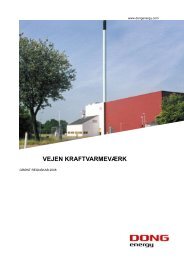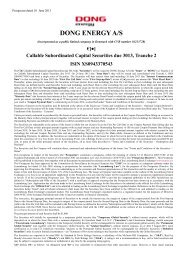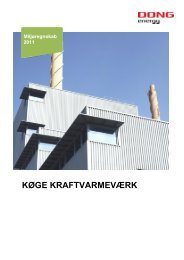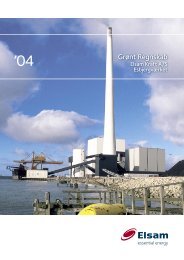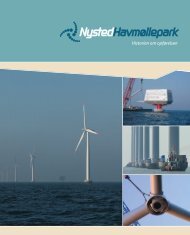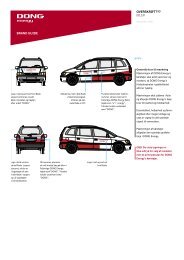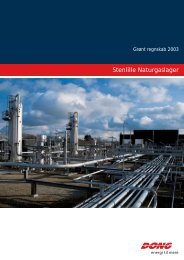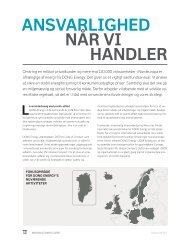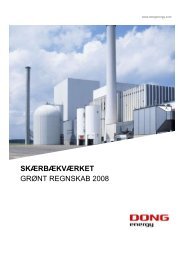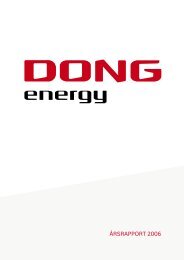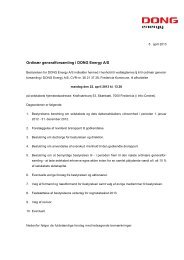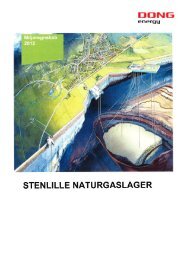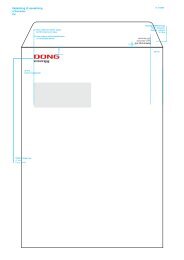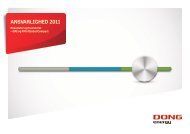ANNUAL REPORT 2011 - DONG Energy
ANNUAL REPORT 2011 - DONG Energy
ANNUAL REPORT 2011 - DONG Energy
You also want an ePaper? Increase the reach of your titles
YUMPU automatically turns print PDFs into web optimized ePapers that Google loves.
RIsk AND RISK MANAGEMENT<br />
risk and risk policy Exposure and hedging<br />
Oil and gas price risks<br />
Oil and gas price risks come primarily from equity production<br />
of oil and gas and from differences in the indexation<br />
of sales and purchase prices for gas.<br />
<strong>DONG</strong> <strong>Energy</strong>’s production of oil contributes to reducing<br />
its oil price exposure from oil price-indexed gas purchase<br />
contracts. The integrated business model thus has<br />
a stabilising effect on the company’s cash flows and overall<br />
risk profile.<br />
The risk to future cash flows from oil and gas price positions<br />
is managed with a time frame of five years based<br />
on a target for Cash-Flow-at-Risk. Oil and gas exposures<br />
are hedged after adjustment for hydrocarbon taxation to<br />
achieve the desired cash flow effect after tax.<br />
The oil and gas exposure profile is expected to change<br />
in the years to come, primarily due to rising equity production<br />
of oil. <strong>DONG</strong> <strong>Energy</strong> will be affected financially<br />
when oil and gas price trends diverge in the short term<br />
(decouple), as was the case in 2009-<strong>2011</strong>.<br />
The long-term purchase and sales contracts contain<br />
embedded options, for example in the form of volume<br />
flexibility and renegotiation clauses that may alter <strong>DONG</strong><br />
<strong>Energy</strong>’s risk profile in both the short and the long term.<br />
price risks for thermal electricity generation<br />
The electricity price is determined by fuel prices, weather<br />
conditions, prices for CO emissions allowances and<br />
2<br />
general supply side and demand side characteristics. Risk<br />
management of thermal electricity generation is based on<br />
freezing the contribution margin for future electricity<br />
generation by selling electricity and buying fuel and CO . 2<br />
The spread-based price exposure for the Danish and<br />
foreign electricity generation is managed with a time<br />
frame of up to five years. The time frame reflects the given<br />
liquidity conditions for trading in the forward market.<br />
The strategic measures involving adaptation of Danish<br />
thermal electricity generation and the establishment of<br />
new gas-fired power stations in the UK (Severn) and the<br />
Netherlands (Enecogen) will, in the years to come, reduce<br />
<strong>DONG</strong> <strong>Energy</strong>’s electricity exposure to Nord Pool from<br />
67% of the value in 2007 to an expected 12% in 2015. This<br />
will contribute to a more diversified position in the market.<br />
46<br />
manaGEmEnt’s rEviEw – <strong>DONG</strong> ENERGY GROUP <strong>ANNUAL</strong> <strong>ANNUAL</strong> <strong>REPORT</strong> <strong>REPORT</strong> <strong>2011</strong> <strong>2011</strong><br />
Overall, <strong>DONG</strong> <strong>Energy</strong>’s oil and gas exposure consists of a<br />
long gas position (positive effect if prices rise) and a short<br />
oil position. As oil and gas prices have, historically, correlated<br />
positively over long periods of time, the long gas exposure<br />
will, to some extent, be offset by the short oil exposure,<br />
reducing the direct gas price exposure. The net oil<br />
and gas price exposure is treated as a spread risk.<br />
In the very short term, the exposure profile may differ<br />
from the normal profile. For example, this is the case for oil<br />
exposure in 2012, which is marginally long as the proportion<br />
of oil-indexed gas sales contracts that have been entered<br />
into is higher than normal.<br />
At the end of <strong>2011</strong>, 28% of the expected oil exposure<br />
and 91% of the expected gas exposure for 2012 had been<br />
hedged, equivalent to a total hedging percentage of 79%<br />
for oil and gas.<br />
In 2012, a 10% decrease in the price of oil and gas<br />
would reduce EBITDA after hydrocarbon tax by DKK 117<br />
million.<br />
Exposure profile for oil and gas in 2012, DKK billion<br />
6<br />
5<br />
4<br />
3<br />
2<br />
1<br />
0<br />
Commercial exposure Net exposure<br />
Oil<br />
Oil and gas<br />
At the end of <strong>2011</strong>, the price exposure relating to 56% of<br />
expected generation in 2012 for Denmark, the Netherlands<br />
and the UK had been hedged.<br />
Exposure profile for thermal electricity generation in 2012,<br />
DKK billion<br />
0.7<br />
0.6<br />
0.5<br />
0.4<br />
0.3<br />
0.2<br />
0.1<br />
0.0<br />
Denmark<br />
Gas<br />
Commercial exposure Net exposure<br />
UK and The Netherlands<br />
Efter afdæknin<br />
Før afdækning<br />
Efter afdæknin<br />
Før afdækning



